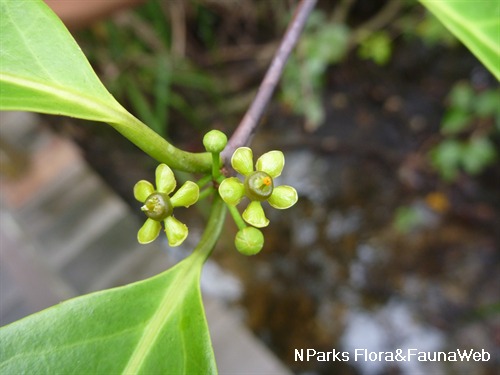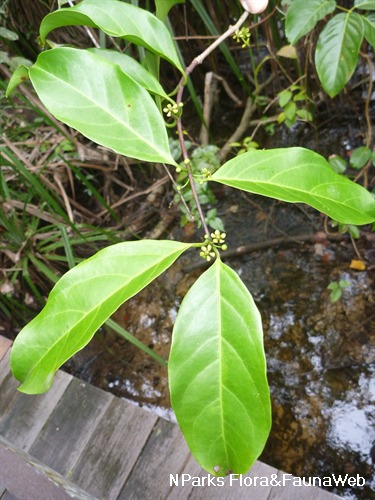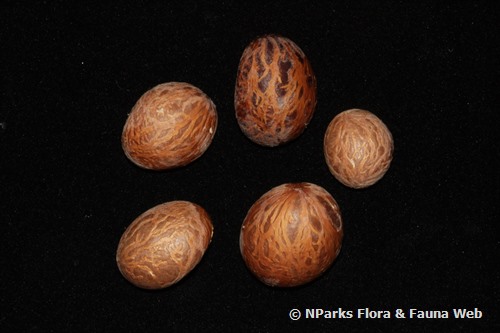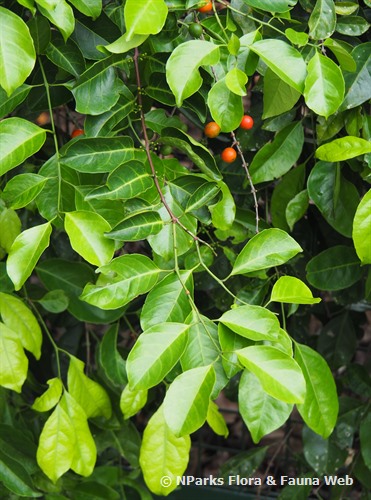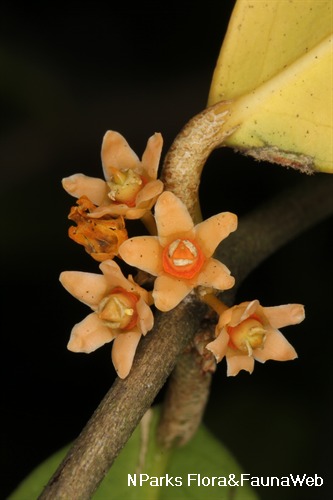
Back
Salacia chinensis L.
| Family Name: | Celastraceae |
| Synonyms: | Salacia prinoides DC., Salacia latifolia Wall. ex Laws. |
| Common Name: | Akan Pelanduk, Anok, Daun Puyu, Ki Telor, Mata Pelanduk, Matang Ulang, 五层龙 |
Name
Classifications and Characteristics
| Plant Division | Angiosperms (Flowering Seed Plants) (Dicotyledon) |
|---|---|
| Plant Growth Form | Climber |
| Lifespan (in Singapore) | Perennial |
| Mode of Nutrition | Autotrophic |
| Plant Shape | Irregular |
Biogeography
| Native Distribution | India, Sri Lanka, China, and Southeast Asia to New Guinea |
|---|---|
| Native Habitat | Terrestrial (Primary Rainforest, Secondary Rainforest, Coastal Forest, Riverine) |
| Preferred Climate Zone | Tropical, Sub-Tropical / Monsoonal |
| Local Conservation Status | Native to Singapore (Critically Endangered (CR)) |
Description and Ethnobotany
| Growth Form | It is a climber, or climbing shrub, and rarely a tree. |
|---|---|
| Foliage | Its stalked leaves are in opposite pairs, each pair at right angles to the next. Its slightly leathery leaf blades are egg-shaped, broadly oval to lance-shaped, and 4–17 by 1.8–9.5 cm. |
| Flowers | The yellowish or yellowish-green, stalked flowers grow in clusters or bundles of few to many flowers. They also have ring-shaped to cushion-like disks. |
| Fruit | Its round fruits are red or orange-red when ripe and 1.3–2 cm wide. Each fruit usually has one spherical seed that is 1–1.5 cm wide. |
| Habitat | It grows in forests along the seashore and sandy riverbanks, and in lowland primary forests up to 450 m altitude. It occurs locally in Mandai Forest and Pulau Ubin. |
| Associated Fauna | Its flowers are insect-pollinated. Its fruits are probably eaten by mammals. |
| Cultivation | It can be propagated by seed. |
| Etymology | Latin Salacia, from Greek mythology, the wife of Neptune, goddess of the sea; Latin chinensis, of China, referring to one locality in the natural distribution of this species |
| Ethnobotanical Uses | Edible Plant Parts : Edible Fruits Food (Fruit or Vegetable): Its fruits contain a little pulp, which is edible. Medicinal: Its roots are used as an astringent, against amenorrhoea, and to cause abortion. |
Landscaping Features
| Landscaping | It may be suitable for parks. |
|---|---|
| Desirable Plant Features | Ornamental Fruits |
| Landscape Uses | General, Parks & Gardens, Small Gardens, Coastal, Trellis / Arbour / Pergola |
Fauna, Pollination and Dispersal
| Pollination Method(s) | Biotic (Fauna) |
|---|---|
| Seed or Spore Dispersal | Biotic (Fauna) |
Plant Care and Propagation
| Light Preference | Full Sun |
|---|---|
| Water Preference | Moderate Water |
| Plant Growth Rate | Moderate |
| Rootzone Tolerance | Moist Soils, Well-Drained Soils, Saline Soils / Salt Spray, Fertile Loamy Soils |
| Propagation Method | Seed |
Foliar
| Foliage Retention | Evergreen |
|---|---|
| Mature Foliage Colour(s) | Green |
| Mature Foliage Texture(s) | Leathery |
| Foliar Type | Simple / Unifoliate |
| Foliar Arrangement Along Stem | Opposite |
| Foliar Attachment to Stem | Petiolate |
| Foliar Shape(s) | Non-Palm Foliage (Ovate, Oval, Lanceolate, Elliptical) |
| Foliar Venation | Pinnate / Net |
Floral (Angiosperm)
| Flower & Plant Sexuality | Bisexual Flowers |
| Flower Colour(s) | Green |
|---|---|
| Flower Grouping | Cluster / Inflorescence |
| Flower Location | Axillary |
| Flower Symmetry | Radial |
Fruit, Seed and Spore
| Mature Fruit Colour(s) | Orange, Red |
|---|---|
| Fruit Classification | Simple Fruit |
| Fruit Type | Fleshy Fruit , Non-Accessory Fruit |
Image Repository
Others
| Master ID | 31616 |
|---|---|
| Species ID | 6015 |
| Flora Disclaimer | The information in this website has been compiled from reliable sources, such as reference works on medicinal plants. It is not a substitute for medical advice or treatment and NParks does not purport to provide any medical advice. Readers should always consult his/her physician before using or consuming a plant for medicinal purposes. |

